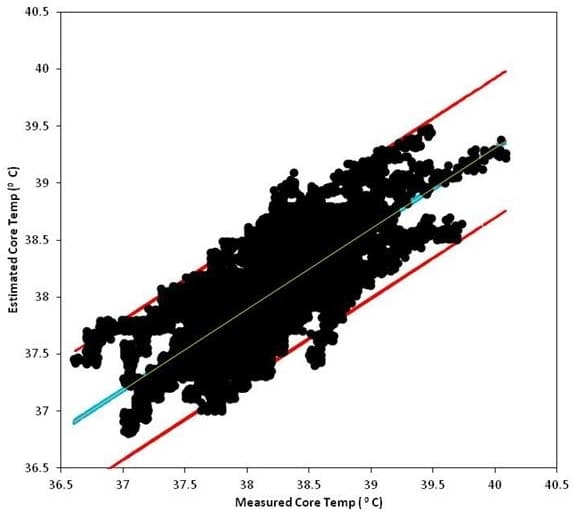Firefighters, may experience high environmental temperatures or carry out intensive physical tasks, or both, which leads to increased core body temperature and increased risk of fatalities. Hence, there is a need to remotely and non-invasively monitor core body temperature. The aim of the present study was to determine the suitability of a non invasive approach to determine core body temperature in firefighters. Estimated (heart rate algorithm – Buller et al. 2013) and actual core body temperature (ingested telemetric pill) measures were collected simultaneously during firefighter training exercises (Average external temperature range 120 – 250 0C) on 44 firefighter volunteers (age 34.1 ± 8.4 years, body mass 82.8 ± 12.7 kg, height 177.4 ± 7.7 cm) whilst wearing personal protective equipment (PPE). Prediction varied by individual, with no specific identifiable pattern between the algorithm values and directly measured body core temperatures. The group agreement value of Lin’s Concordance of 0.74 (95% Upper 0.75, lower CI 0.73), was deemed poor. It could be seen from individual agreement data that the Lin’s Concordance was variable (Min 0.11, 95 % CI 0.13 – 0.01; Max 0.83, 95 % CI 0.86 – 0.80). From the observed associations between the two methods, the data indicated that the heart rate algorithm approach was not suitable for core body temperature monitoring in this population group, especially at the higher more critical core body temperatures seen.
Extreme Environmental Physiology (University of Portsmouth, UK) (2019) Proc Physiol Soc 44, C42
Oral Communications: Comparisons of core body temperature between an ingested telemetric pill and heart rate estimated core body temperature in firefighters
S. Pearson1, M. Matthews1
1. Health & Society, University of Salford, Manchester, United Kingdom.
View other abstracts by:
Where applicable, experiments conform with Society ethical requirements.

